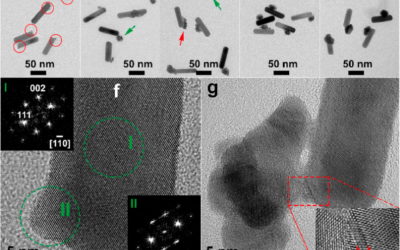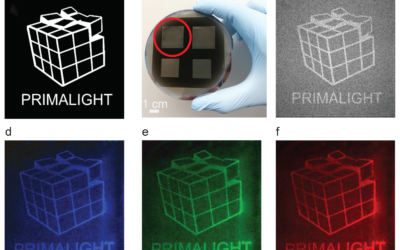
Ultra-dense free electrons liquid metasurfaces
Controlling broadband light in nanoscale volumes is a desired goal in nanophotonics. Metastructures tackle this problem by subwavelength nanostructured patterns. The current technology reaches footprints of 50 nm with plasmonic nanostructures. Scaling down these...
Perfect absorbers and a new source of light from darkness
Engineering broadband light absorbers is crucial to many applications, including energy-harvesting devices and optical interconnects. The performances of an ideal absorber are that of a black body, a dark material that absorbs radiation at all angles and...
Homogeneously Alloyed AuAg Shell with tunable Surface Plasmon Resonances
Colloidal metal nanocrystals with strong, stable, and tunable localized surface plasmon resonances (SPRs) can be useful in a corrosive environment for many applications including field‐enhanced spectroscopies, plasmon‐mediated catalysis, etc. Here, a new synthetic...
Au Nanorod–Au Nanoparticle Dimers
Asymmetric nanocrystals have practical significance in nanotechnologies but present fundamental synthetic challenges. Thiol ligands have proven effective in breaking the symmetric growth of metallic nanocrystals but their exact roles in the synthesis remain elusive....
Evolutionary Photonics for Renewable Energy, Nanomedicine, and Advanced Materials (Invited Review)
Taking inspiration from complex natural phenomena such as chaos and unpredictability, as well as highly optimized organisms constituted by multitudes of interacting cells, evolutionary photonics aims at developing new sustainable technologies for renewable energy...
Broadband Holography via Structured Black Silicon Nano-Antennas
Computer-generated holograms have wide applications in different fields of optics, ranging from imaging, to data storage and security. Current holograms have limited bandwidth and are generated via nanofabrication techniques that are difficult to scale up and in some...
Scalable, ultra-resistant structural colors based on network metamaterials
Structural colors have drawn wide attention for their potential as a future printing technology for various applications, ranging from biomimetic tissues to adaptive camouflage materials. However, an efficient approach to realize robust colors with a scalable...
Light Manipulation in Metallic Nanowire Networks with Functional Connectivity
Subwavelength engineered materials, or metamaterials, designed to control the electromagnetic field are highly influenced by microelectronic circuit design, which manifests in the systematic assembly of well‐defined and understood elements in periodic arrays. In this...
The route to strong localization of light
By employing Random Matrix Theory (RMT) and first-principle calculations, we investigated the behavior of Anderson localization in 1D, 2D and 3D systems characterized by a varying disorder. In particular, we considered random binary layer sequences in 1D and...
Quntum Anderson localization
Fifty years after the discovery of Anderson localization, the influence of disorder continues to surprise. In 1958, the US physicist P. W. Anderson discovered the phenomenon of disorder-induced localization while pursuing a general theory of electron transport....











Recent Comments